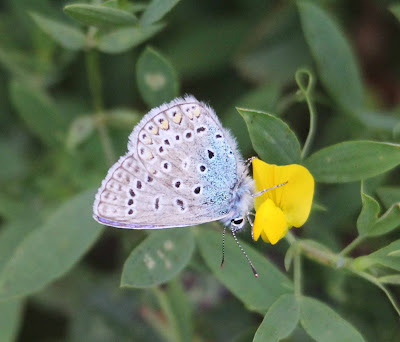 |
| One of two Nutcrackers (nøttekråke) feeding in the garden this morning - note the bulging throat full of nuts! |
I think I’ve been complaining too much about the seawatching
recently afterall I did see 2 good birds in over 6 hours of sea gazing.
Today though I felt I could complain. Over breakfast I
noticed a small creature creeping up my youngest daughter’s hair – a head lice!
Out with the special comb and yes both the girls had them. Well that meant no school
for them, no trip with Rune for me and a trip to the chemist to buy some
poison. After administering the treatment and washing all bedding and towels I
suggested a ride around Fornebu – this is always greeted with enthusiasm.
When we got there just after 1pm it was sunny, warm and
there appeared to be some birds around. First a juvenile Buzzard (musvåk) was
hunting close by (an unusual sight) and hovering before flying over our heads
allowing me some pictures (I am slowly getting the hang of the new lens but am
still not entirely satisified).
 |
| juvenile Buzzard |
In the bushes there seemed to be good numbers of warblers
with many Willow Warblers (løvsanger) and a few Blackcaps (munk) and whilst watching
a young Whinchat (buskskvett) I noticed some movement around some berry bushes.
The first bird I saw was a very large warbler, with noticeable barring on the
undertail coverts, a big eye, a big bill and a generally plain grey plumage.
Like a large Garden Warbler with barring – a Barred Warbler (hauksanger)! It
grabbed a berry and disappeared in the bushes. I tried my best to relocate it
but with two impatient kids I was limited to just hanging around the general
area and occasionally peering at the bushes...without luck. Then when we were
leaving it flew and showed well. In flight it was very distinctive. It
resembled a shrike due to its size, strong bill and undulating flight.
Additional plumage features that I picked up were its prominent wing bars and
the white outer tail feathers which showed very well when it landed. Barred
Warbler is less than annual in these parts and this was an Akershus tick for
me.
Later whilst the kids were playing in a playground a male
Bluethroat (blåstrupe) hopped around some bushes and a couple of Wheaters
(steinskvett) also showed.
 |
| male Bluethroat |
I really got the feeling there had been a mini fall
at Fornebu today and just wonder what would have shown with an early morning
visit.
Butterflies have been more obvious of late in what has
generally been a very poor year for them. I had my first sighting of Brown
Hairstreak (slåpetornstjertvinge) along with a showy Common Blue
(tiriltungeblåvinge) which allowed themselves to be photographed.
 |
| female Borwn Hairstreak |
 |
| male Common Blue |














